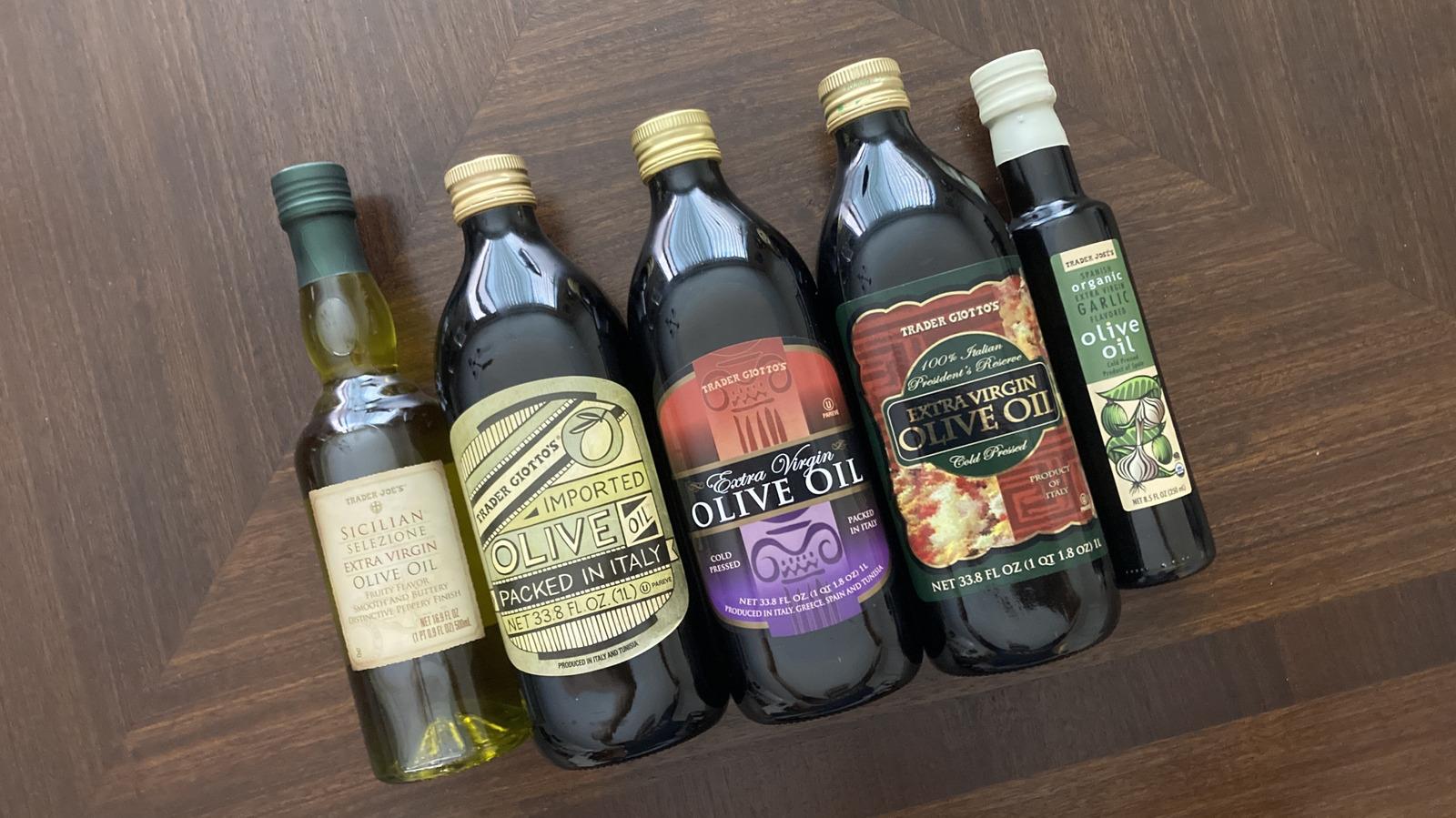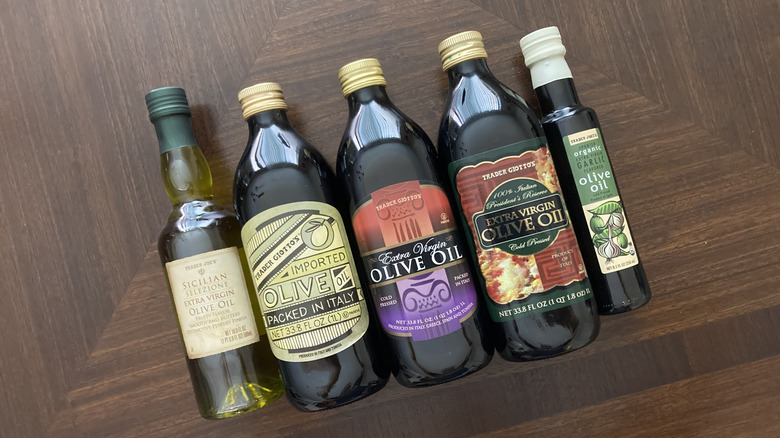
Steven Luna/Mashed
Having choices when shopping for olive oil is a great thing — until you realize that you don't know the difference between extra-virgin and cold-pressed. When the selections in question are gems from Trader Joe's, there's no question that the quality will be on point. Picking the right one becomes a matter of suitability for the use you have in mind; your sautéing oil, your dressing oil, and you're dipping oil could come in three entirely different bottles.
Similar to other Trader Joe's items, the whole collection of olive oil varieties isn't always available in stores at the same time. But even the basic selections provide a range of options to suit your most essential oil needs, with each one providing its own special personality to the situation. And the pricing is one of the reasons Trader Joe's is better than Whole Foods at serving customers quality, high-end oils that are highly affordable.
To see how well each oil fares against its fellow bottles, I picked up the four Trader Joe's olive oils currently carried by my location and ordered a fifth from Amazon. Then, I put them to work in the various ways I usually use olive oil: as a salad and vegetable drizzle, a bread dipper, and a cooking oil (read more on my methodology at the end). Though they're all exceptional purchases, especially for their respective prices, they each have their own distinctive place in the divine olive oil order.
5. Sicilian Selezione Extra Virgin Olive Oil
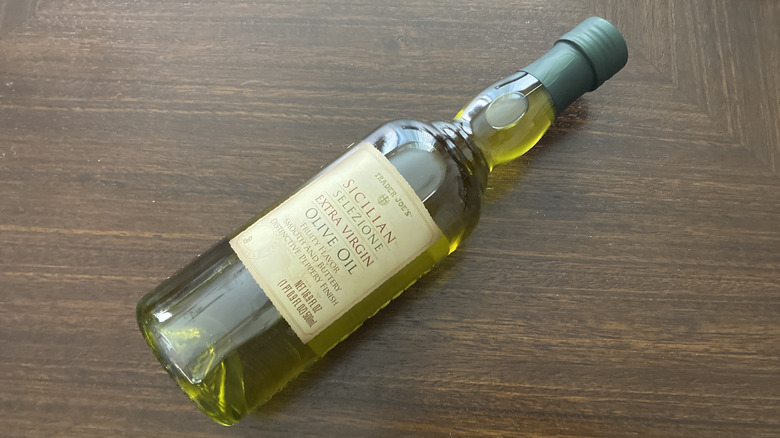
Steven Luna/Mashed
This bottle let loose a slightly green scent when the lid came off and poured smoothly into the dish. Of all the oils in my taste test, it came across closest to canola or basic vegetable oil. That isn't necessarily a bad thing, depending on how you intend to use your olive oil. The label describes a buttery, fruity, and peppery flavor profile, which sounds like a fantastic pour-over for a healthier popcorn snack, finished off with a little black pepper. I did actually taste a bit of green fruit and a touch of butter when dipping bread in this oil, though I didn't discern any peppery finish to speak of.
My pasta test found this bottle to be just as neutral. It's as close to straight-up vegetable oil as any olive oil I've tasted, which probably makes it a prime purchase for anyone who's new to olive oil use. You can get a feel for the similarities and differences before sampling more complex olive oils down the line. As for the salad dressing test, the oil came across as greasy and intrusive. I would avoid using this to make a dressing, knowing that I can get far better performance out of one of the other oils instead.
With a $10.99 price tag, I'd be less likely to buy this bottle knowing how general its uses would be. A cheaper bottle would do just as well.
4. 100% Italian President's Reserve Extra Virgin Olive Oil
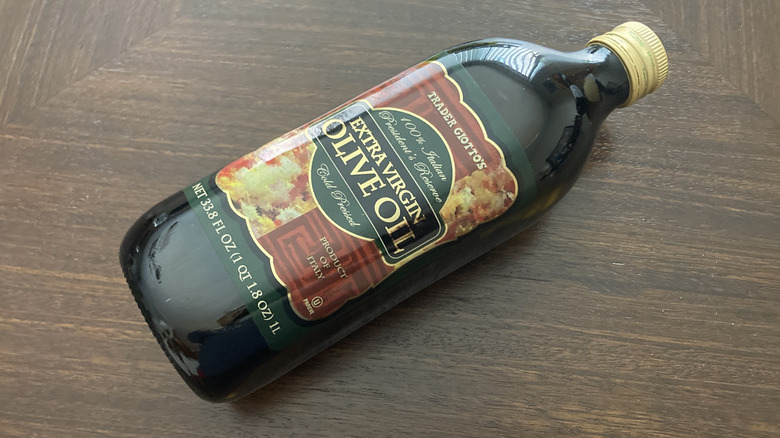
Steven Luna/Mashed
The scent wafting from the bottle was distinctively grassy, almost like a leafy vegetable more than a nutty olive essence. The flavor reminds me of green lettuce, aiming this bottle in the direction of a light, refreshing salad dressing. While the bread test revealed a more basic personality for this oil, adding it to pasta brought out the buttery side of its nature. I would work this bottle into recipes that call for butter, knowing that I have a healthier non-dairy option that results in a nearly identical flavor.
When I tried this oil as a salad dressing, I tasted literally nothing. The good news is that whatever else I add in has free rein without taking on the flavor of the oil. The less-good news is that it further limits the functionality to being more of a base oil than a flavoring oil, a quality that may not justify the price tag.
And speaking of the price tag ... this olive oil is available for $12.99, the most expensive bottle of the bunch. I'd be more likely to buy a general-use olive oil if I needed it in quantity, or at least grab a bottle of one of the higher-placing Trader Joe's olive oils on the list. Either would be a wiser purchase.
3. Imported Olive Oil Packed in Italy
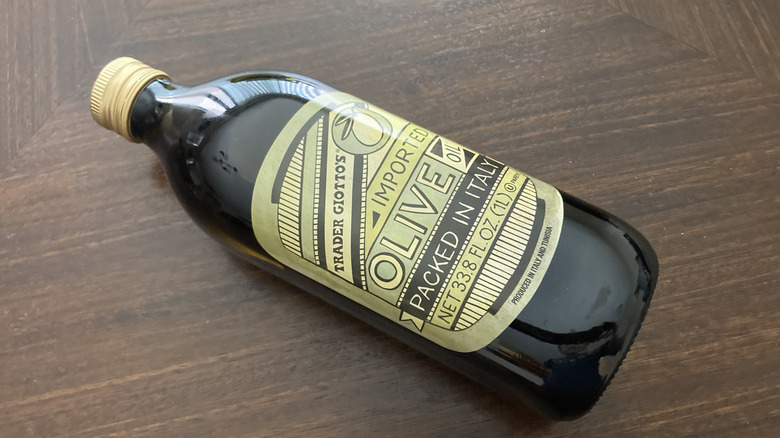
Steven Luna/Mashed
If fragrance is any indication of flavor in the olive oil world, this one presents an entirely neutral prospect. There was no aroma whatsoever in the bottle or out, and the pour was much looser than Trader Joe's other oils. The bread dip test proved that the scent and flavor are the same; there was literally no discernible taste, a quality that means the flavor of your food will shine through when cooked in this oil.
That quality was reinforced further when I tasted the oil over pasta. A slight nuttiness emerged, but it would have been much better served with a bigger set of flavors sharing the pot. It may be odd to think of a flavorless oil as a benefit, but it will prove its worth when used to roast vegetables or become part of a hearty sauce.
Similar-sized bottles of olive oil at major chains can cost $15 or higher. At $9.99 (or so) per 33.8-ounce bottle, this is the kind of olive oil that lets Trader Joe's shoppers react to inflation with a sigh of relief.
2. Spanish Organic Extra Virgin Garlic Flavored Olive Oil
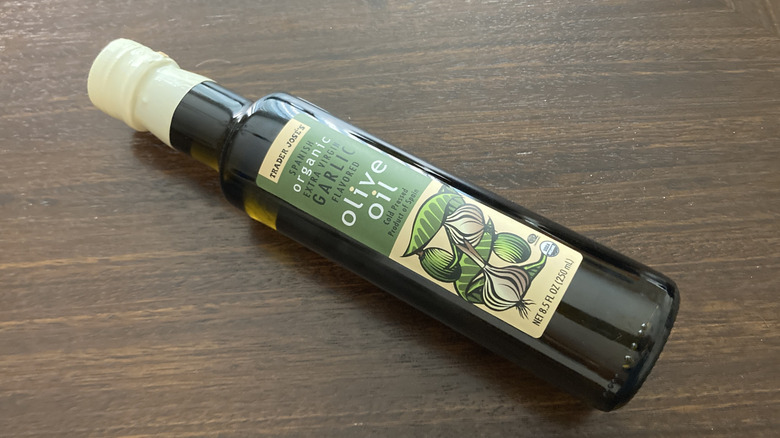
Steven Luna/Mashed
The fragrance of this one leaps out of the bottle as soon as the lid is cracked, filling the kitchen with the lively scent of garlic. The bread dip sampling proved how potent the garlic is in this cold-pressed oil, but it didn't prepare me for the incredible buttery flavor that sits just beneath. This would be my number one choice for sitting out on a table with baguette slices for an easy and effective antipasto. It could just as easily replace both butter and fresh garlic for a garlic bread recipe that only needs two ingredients.
Over pasta, this bottle proved itself to be a standalone drizzle. Ordinarily, I would've shaken on some garlic powder for a quick and easy flavor up. Thanks to the abundant garlic in the oil, there was flavor a-plenty with no enhancement required, making it a must-have for preparing unique, mouthwatering pasta recipes that call for layers of flavor in every ingredient. The garlic spirit even held its own against a splash of balsamic vinegar that I added for the salad dressing test, which means less work for me when I need a quick toss over for my greens.
Among the Trader Joe's olive oils available, this Spanish beauty is a bold and useful addition to the kitchen. When found in stores, it's priced around $6 for an 8.5-ounce bottle, which is a steal for olive oil of any kind.
1. Premium Extra Virgin Olive Oil
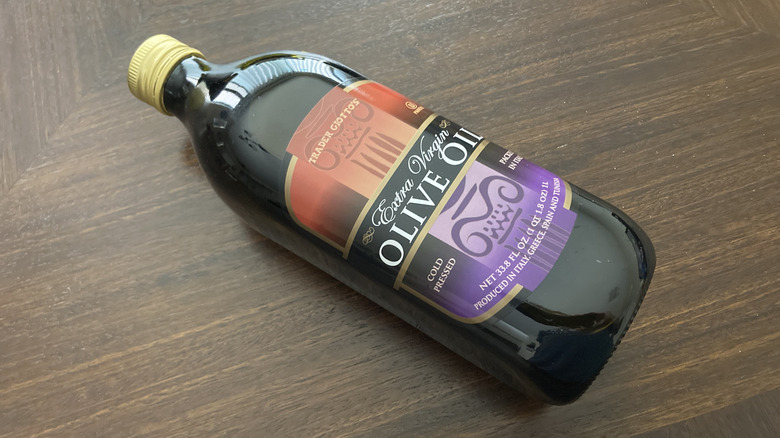
Steven Luna/Mashed
There's a sweet, fruity aroma to this one that reminds me of fresh peaches. I've never noticed anything like that in the usual brands of olive oil that I use; it's the sort of surprise that inspires creative cooks to think about uncommon ways to use olive oil to enhance their recipes. It pours thick and silky from the bottle, a clue that there's a richer flavor that makes for a more lively culinary partner. The same peachy notes came through in the tasting, which made me dip more bread in it than I intended to. It's an elegantly sweet oil that would go well dressed up with fresh herbs as part of a cheese plate, though it's flavorful enough all on its own to not need any adornment.
The peachy flavor was less noticeable when I tried this oil on pasta, but it provided a notable sweetness that brightened up with a little salt. This would be my go-to for primavera dishes, where freshness is key and a light hand works best for delivering flavors. And as a salad dressing, it seems to work perfectly as a stand-alone, though it brightens up with a little balsamic vinegar. It would go great with tart fruit like Granny Smith apples and cranberries in a green salad.
This 33.8-ounce bottle was $10.99 at my Trader Joe's location, but I would happily pay more to have an olive oil with such a distinctive personality in my arsenal.
Methodology
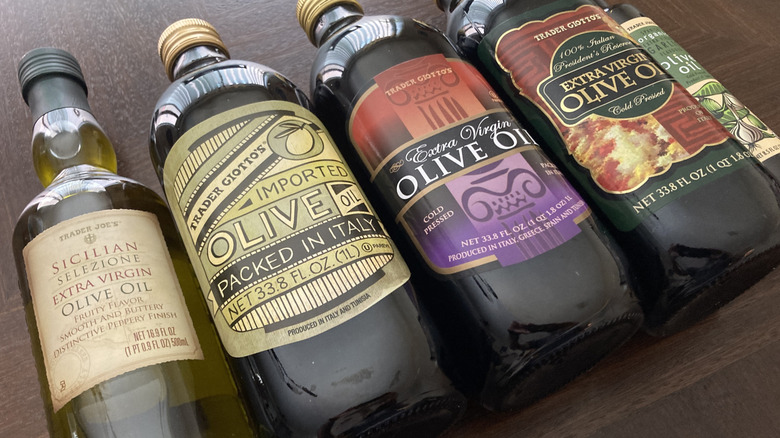
Steven Luna/Mashed
I started my testing by cracking open the bottle and taking note of the bouquet each oil offered. It gave me a hint of what might be waiting flavor-wise. I poured a little of each into its own dish, taking note of how viscous the pouring quality was. This let me know the body of the oil and clued me in on how well it would incorporate into various recipes. These pre-tasting qualities are important when choosing the right olive oil for the right task.
To sample the flavors, I dipped a bit of bread into the raw oil and tasted it as-is first; this let me know how well the oil would work as table oil, which calls for a flavorful oil with a silken texture rather than a slick, greasy oil. Then, I tossed a few pieces of pasta into the oil and took a taste with no other seasoning; this gave me an idea of how the oil would work as a simple pasta topper, as well as providing a sense of how nicely it could serve as part of a more complex sauce.
Lastly, I drizzled a little of each oil over a lettuce leaf to determine what kind of salad dressing it might make. I also added a bit of balsamic to figure out how well the oil could hold its own with a more powerful ingredient as part of the dressing.



